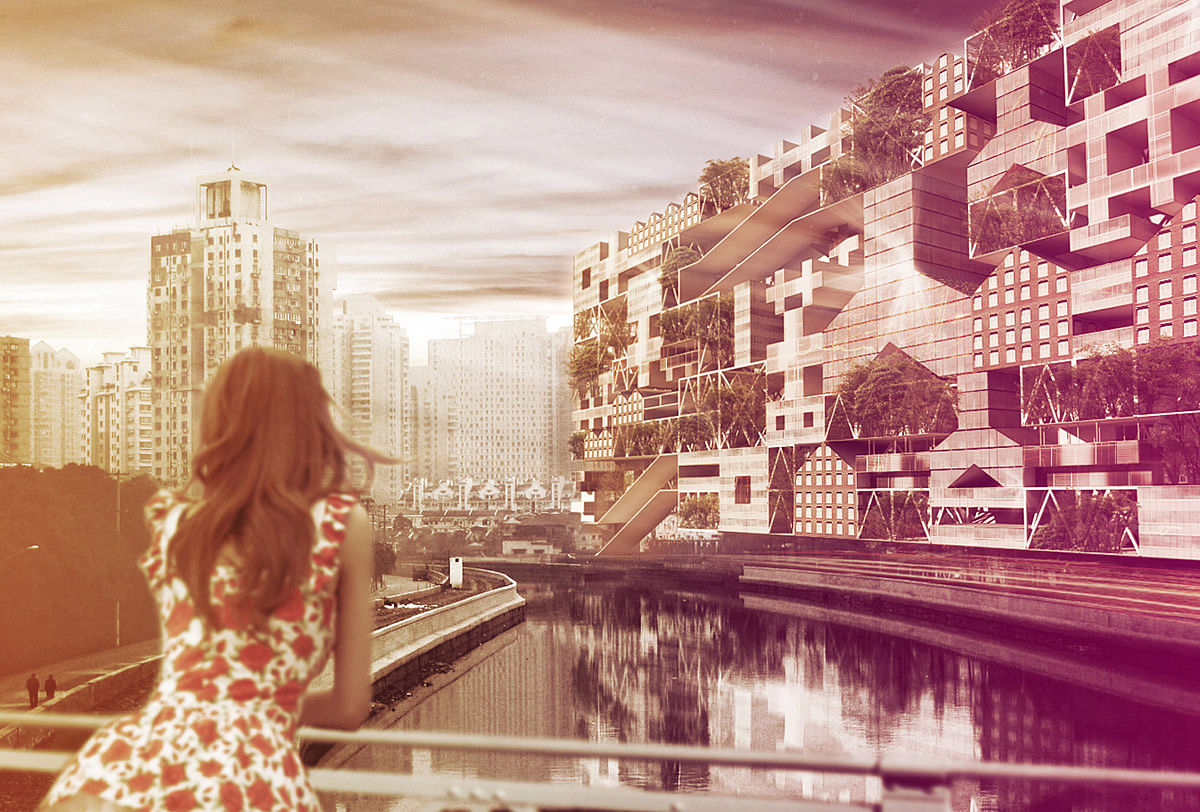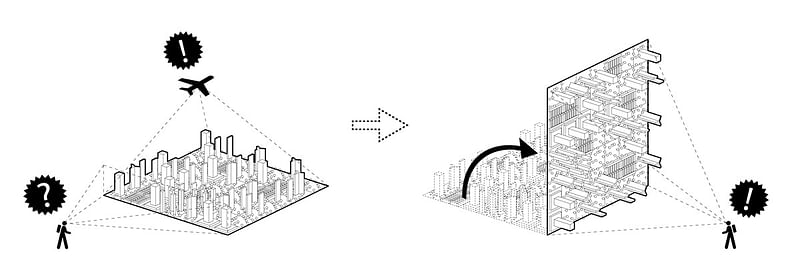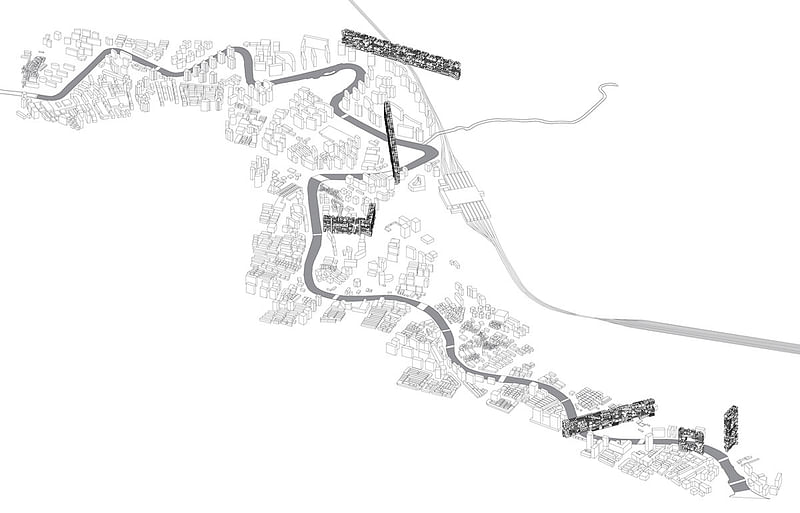FLIP/CITY SHANGHAI by PinkCloud.dk
By Bustler Editors|
Tuesday, Jun 12, 2012

Related
Copenhagen firm PinkCloud.dk has shared with us the concept FLIP/CITY, a recent shortlist entry in the 2012 Rethinking Shanghai competition. Design team members Nico Schlapps and Fabian Busse decided to literally flip a flat cityscape vertically to create, explore and grow new types of spaces.
Project Description from the Architects:
FLIP/CITY proposes a new urban identity for Shanghai as a model for the development of future cities.
By questioning traditional typologies, FLIP/CITY redefines methods of organizing communities by preserving the human scale.

The proposal flips the horizontal cityscape to the vertical.
Footprints of Shanghai’s existing typologies, only visible by plane, embody the new face of the vertical city. By expressing distinct functions for its citizens, FLIP/CITY relates strongly to the human scale while simultaneously increasing density and green space at the urban scale.



By expanding Shanghai up along the vertical plane unused urban voids will be activated. Proximity and numerous informal meeting spaces catalyze synergy and a vivid community life.
FLIP/CITY is a new urban typology that answers the needs of modern Shanghai, its economy, social structures and ecological plans for the future while embracing Shanghai’s rich history and its citizens.

VISION
Imagine a city of a unique new typology that meets the needs of its inhabitants while maximizing the quality of life and work. This typology would embrace communities and their citizens as a flexible framework which adapts to environmental and economic changes. As a reactive healing force, this city could renew weak urban zones in decline by filling voids and dead space with functioning, thriving neighborhoods. Most importantly, this new typology would have the capacity to maximize green space and solve infrastructural issues while creating an efficient, accessible circulation system for public transit.

CONCEPT
FLIP/CITY realizes this urban typology in the context of Shanghai, a prime location for sustainable innovation at an immense scale. Shanghai faces problems incurred by high population density, heavy pollution, rapid growth, and decreasing viable land.
FLIP/CITY challenges these issues by transforming the orientation of Shanghai’s city grid. The proposal flips the cityscape from the horizontal plane to the vertical plane, thereby generating a new typology. In this model, the footprints of Shanghai’s existing typologies, only visible on maps or by plane, embody the new face of the vertical city. By literally expressing distinct functions for its citizens, FLIP/CITY relates strongly to the human scale while simultaneously increasing density and green space at the urban scale.

WHY?
Shanghai’s exponential population growth was incurred by its international importance as a financial epicenter. This population boom lead to the import of Western urban typologies in Shanghai. While the high-rise typology effectively challenges high density with a small footprint, it is typically plagued with a homogeneous function. This contributes to the issue of exclusivity of the city center as a commercial zone. City centers often resemble the financial hub of the city, gradually extending into residential sprawl. This necessitates more transportation infrastructure to bridge long distances between office and residence. High-rise typologies also lose the intimacy of the human scale, forcing citizens to live and work in increasingly alienating, pollutive, and disconnected environments.

HOW?
By expanding Shanghai up along the vertical plane, Shanghai’s characteristic urban pattern of patchwork typologies can accommodate a wider range of functions. Residential, commercial, educational, cultural, and infrastructural functions are arranged at the human scale to enable walking distance between all vital functions. Urban voids and abandoned sites are infilled with infrastructural installations and equipment. 3-Dimensional blocking in the vertical village constructs more numerous meeting spaces and communal green zones for the public.

Micro Scale
Seven modular typologies are constructed in the micro scale (House, Y, O, =, ?), visible from the human eye at street scale. Each typology houses a function that is clearly readable from near and far distances. This enables clear wayfinding and navigation for inhabitants.

Macro Scale
Unique typologies are configured and distributed with a parametric algorithm to maintain human scale throughout the project. The designer can choose the number of housing and office modules and select the density and footprint. The algorithm optimizes the arrangement of modules into close communities and uses site-specific qualities as parameters to optimize the composition.

Mega Scale
The mega-scale of FLIP/CITY uses different footprints to optimize the parametric arrangement of its modules. The proposal is adaptable to a wide range of situations from environmental influences to social structures. We have selected six diverse sites with unique urban problems for analysis. All six scenarios are tested with the FLIP/CITY model to test its flexibility and adaptability.

SUSTAINABILITY
FLIP/CITY addresses four crucial aspects of sustainability. In the realm of social sustainability, the anonymous feeling of immense cities is challenged by interconnecting typically isolated diverse city zones. In the economical sense, increase green space invigorates the morale of Shanghai’s dense society. Dead spaces, voids and abandoned sites are also renewed. Ecological sustainability is achieved by recycling greywater of the Suzhou Creek. Heating and cooling is accomplished by collecting solar and wind energy. Finally, FLIP/CITY sustains the cultural heritage of Shanghai by reinterpreting its historical urban framework.

IMPACT
FLIP/CITY proposes a new urban identity for Shanghai as a model for the development of future cities. By questioning traditional typologies, FLIP/CITY redefines historical methods of organizing communities by preserving intimacy at the human scale. FLIP/CITY utilizes the naturally high population density of Shanghai as a tool to connect its citizens in close proximity to their needs.
By re-thinking our standard urban typologies, we can effectively re-think Shanghai.
FLIP/CITY is a new urban typology that answers the needs of modern Shanghai, its economy, social structures and ecological plans for the future while embracing Shanghai’s rich history and its citizens.


Share
0 Comments
Comment as :